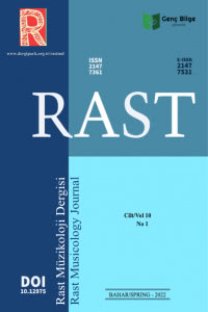Issues of Musical Identity During The Foundation of The Turkish Republic (1923-1950)
In the early years of the Turkish Republic, music was a central topic in the cultural reforms thataimed to guide Turkey in the modernism and progressivism that defined the first half of thetwentieth century. Several issues were involved, including the “change of civilizations” from anOttoman and Eastern identity to becoming more like a Western European nation-state. This wasa period that saw the establishment of Western-style music conservatories and the employmentof musicians and musicologists to help establish a national classical music based on Turkishfolk elements. At the same time, media outlets such as radio helped to shape and disseminate anational folk musical style. Private music making and cultural exchange with the West alsoplayed an important role in shaping a new Ottoman style. All of these elements worked togetherto form a rich and complex fabric of musical identity during the early days of the TurkishRepublic.
Anahtar Kelimeler:
Turkish Republic, National Identity, Cultural Reforms, Classical Music, Folk Music
___
- Ahmad, F. (1993). The making of modern Turkey. London: Routledge. Aksin, S. (2007). Turkey, from Empire to Revolutionary Republic: The Emergence of the Turkish Nation from 1789 to Present. New York: NYU Press. Atabaki, T., and Zurcher, E. J. (Eds.). (2004) Men of Order: Authoritarian Modernization Under Atatürk and Reza Shah, London and New York: I.B. Tauris Publishers. Balfour, J.P.D., and Kinross, B. (1964). Atatürk. The Rebirth of a Nation. Weidenfeld & Nicolson. Duygulu, M. “Turkish Folk Music in the Process of Social Change and Globalization: Identity, Style, Technique.” Turkish Music Portal, http://www.turkishmusicportal.org/ article.php?id=22&lang2=en, (accessed 13 February 2016). Feldman, W. (1996). Music of the Ottoman Court: Makam, Composition and the Early Ottoman Instrumental Repertoire (Vol. 10). VWB-Verlag für Wissenschaft und Bildung. Gökalp, Z. (1968). The Principles of Turkism (translated from the Turkish and annotated by Robert Devereux). Leiden: Brill. Karpat, K. H. (Ed.). (1973). Social change and politics in Turkey: A structural-historical analysis (Vol. 7). Leiden: Brill. Keyder, Ç. (Ed.). (1999). İstanbul: Between the Global and the Local, Maryland: Rowman & Littlefield. “Love and Melancholy,” from Turkish Music from Past to Present. Turkey: Türkiye İşbank Cultural Productions. Say, A. (1995). The Music Makers in Turkey, Turkey: Music Encyclopedia Publication. Saygun, A. A. (1936). Türk halk mûsikîsinde pentatonism. Nümune Matbaasi. Schick, I. C., and Tonak, E. A. (Eds.). (1987). Turkey in Transition: New Perspectives. New York and Oxford: Oxford University Press, 1987. Schulze, K. E., Stokes, M., and Campbell, C. (Eds.). (1996). Nationalism, Minorities, and Diasporas: Identities and Rights in the Middle East. London and New York: I.B. Tauris Publishers. Signell, K. L. (1979). Makam: Modal Practice in Turkish Art Music. “Songs of Passion.” Turkish Music from Past to Present. Turkey: Türkiye İşbank Cultural Productions. Sterling, P. (Ed.). (1993). Culture and Economy: Changes in Turkish Villages, England: The Eothen Press. Stokes, M. (1992). The Arabesk Debate. Oxford: Clarendon Press. Zurcher, E. (2004). Turkey: A Modern History, Revised Edition. New York: I. B. Tauris.
- ISSN: 2147-7361
- Yayın Aralığı: Yılda 4 Sayı
- Başlangıç: 2013
- Yayıncı: Genç Bilge Yayıncılık (Young Wise)
Sayıdaki Diğer Makaleler
TURKISH HISTORY THESIS AS A LEGITIMIZING INSTRUMENT IN MUSIC DEBATES OF EARLY REPUBLICAN TURKEY
Music in Ottoman Higher Education
Türk Tasavvuf Mûsikisi İlâhilerine Yapısalcı Bir Yaklaşım: “İrfân-ı Aşk” Albümü Örneği
Sosyo-Kültürel Bir Müzik İcra Ortamı Olarak Âşık Kahveleri ve Bursa Âşıklar Kahvesi
“Mûsikî İnkilâbı”nı Osmanlı-Türk Modernleşmesinin Kültürel ve Siyasi Mirasi Olarak Yorumlamak
Fasıl Müziği İcrasında Nota Dışı Farklılıklar
Nesibe Özgül TURGAY, Ruhi AYANGİL
Namık Sinan TURAN, Bilen IŞIKTAŞ
Issues of Musical Identity During The Foundation of The Turkish Republic (1923-1950)
